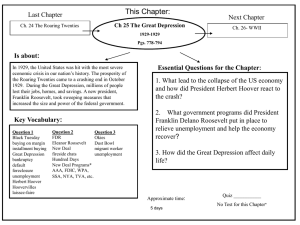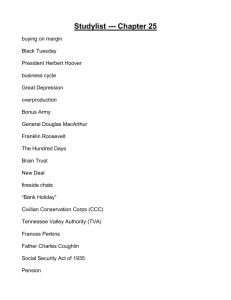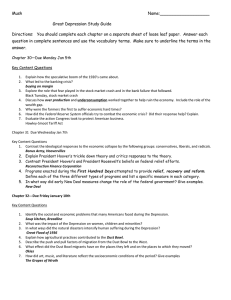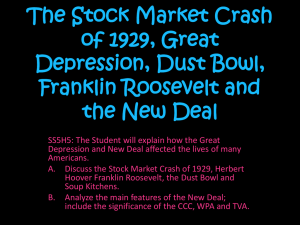11. The Great Depression and the New Deal
advertisement
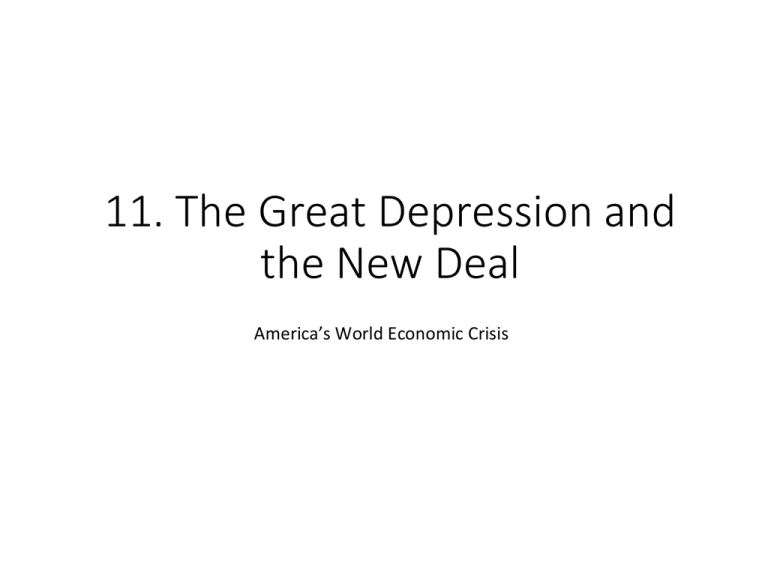
11. The Great Depression and the New Deal America’s World Economic Crisis Causes of the Great Depression 1. Overproduction of goods (Produced more than they could sell) 2. Speculation led to the 1929 stock crash 1. People invested in rising stock prices. 2. Speculation in real estate holdings. 3. In October 1929,k stock prices fell in a crash 3. 4. Uneven distribution of wealth Shaky Banking Practices. /bankers invested depositors’ money poorly. 5. Restricted International Trade / tariffs were so high it restricted international trade New York Stock Market Crash • October, 1929 crash set off a chain reaction. • Investors lost savings • Companies could not sell stocks to raise money • Factories closed • Prices dropped • Unemployment grew • People lost their homes • Americans blamed President Herbert Hoover. What Depression Looked Like • No safety net. • Make-shift shanty homes, known as “Hoovervilles” appeared in the outskirts of towns. • Many people relied on soup kitchens for food. • Recording the Misery: • Dorothea Lange: Recorded the misery of the people in photographs • John Steinbeck: Wrote about the suffering of migrant families during the depression in a series of articles. An Environmental Disaster • On the Great Plains • Spell of dry weather in the 1930s turned the soil into dust • Giant wind storms swept the dust away • Farmers had to leave the Dust Bowl. • Many farmers settled in California • About half a million Mexican-American workers were forced to return to Mexico (Mexican Repatriation Program) President Hoover’s Response • Cut taxes • Established the Reconstruction Finance Corporation to make loans to banks and businesses. • Felt that the Depression would go away on it’s own. • Failed to provide direct emergency relief since he believed it would undermine American’s “Rugged Individualism.” Franklin Roosevelt and the New Deal • President Roosevelt established a Brain Trust of talented advisers. • Fireside Chats. Used the radio to speak directly to Americans • New Deal was President Franklin Roosevelt’s program for lifting the nation out of the Great Depression • Called congress into special session to pass this legislation. • Most was passed in a 100 days • Consisted of programs focused on “Relief, Recovery, and Reform. Relief • Short term actions designed to tide people over until the economy recovered. • Bank Holiday. Closed all the banks for a period of time. • Created government jobs to get people back to work. • Civilian Conservation Corps (CCC) • Public Works Administration (PWA) • Works Progress Administration (WPA) Recovery • Restore incentives to produce. • Priming the Pump • National Recovery Administration (NRA) • Agricultural Adjustment Acts (AAA) Reform • Measures to remedy defects of the U.S. economy to prevent future depressions. • FDIC. Insured bank deposits to restore people’s confidence in the Nation's banks. • SEC. A watchdog agency to watch over stock markets and prevent another collapse. • Social Security Act. Provided a safety net for workers with unemployment insurance, old age pensions, and insurance for families of those who died early: paid for by contributions by both employees and employers. The Supreme Court and the New Deal • The U.S. Supreme Court overruled part of the New Deal in Schechter v. U.S. on the grounds that the president had exceeded his constitutional powers. • In response, Roosevelt developed his Court Packing Scheme, where he proposed that the President be able to add new justices for every one over 71 years old. • Failed and American public was outraged at the attempt. Key Individuals • Herbert Hoover. President when the Great Depression began. Believed in “rugged individualism: and failed to take enough measures against the problem. • Franklin D. Roosevelt (FDR). Elected President in 1932; introduced a New Deal program to get the economy moving again. • John Steinbeck. Writer during the Great Depression. Wrote The Grapes of Wrath • Eleanor Roosevelt. A political activist, who served as the eyes and ears to her husband, President Roosevelt.
